Births
| | This section is empty. You can help by adding to it. (July 2019) |
| 1680s in South Africa | ||
| 1660s 1670s « 1680s » 1690s 1700s | ||
| List of years in South Africa | ||
The following lists events that happened during the 1680s in South Africa .
| | This section is empty. You can help by adding to it. (July 2019) |
The written history of the Cape Colony in what is now South Africa began when Portuguese navigator Bartolomeu Dias became the first modern European to round the Cape of Good Hope in 1488. In 1497, Vasco da Gama sailed along the whole coast of South Africa on his way to India, landed at St Helena Bay for 8 days, and made a detailed description of the area. The Portuguese, attracted by the riches of Asia, made no permanent settlement at the Cape Colony. However, the Dutch East India Company (VOC) settled the area as a location where vessels could restock water and provisions.

The Great Trek was a Northward migration of Dutch-speaking settlers who travelled by wagon trains from the Cape Colony into the interior of modern South Africa from 1836 onwards, seeking to live beyond the Cape's British colonial administration. The Great Trek resulted from the culmination of tensions between rural descendants of the Cape's original European settlers, known collectively as Boers, and the British Empire. It was also reflective of an increasingly common trend among individual Boer communities to pursue an isolationist and semi-nomadic lifestyle away from the developing administrative complexities in Cape Town. Boers who took part in the Great Trek identified themselves as voortrekkers, meaning "pioneers", "pathfinders" in Dutch and Afrikaans.
The following lists events that happened during the 1730s in South Africa.
The following lists events that happened during the 1690s in South Africa.

Simon van der Stel was the last commander and first Governor of the Dutch Cape Colony, the settlement at the Cape of Good Hope.

De Tuynhuys is the Cape Town office of the president of South Africa.
The area known today as Cape Town has no written history before it was first mentioned by Portuguese explorer Bartholomeu Dias in 1488. The German anthropologist Theophilus Hahn recorded that the original name of the area was '||Hui !Gais' – a toponym in the indigenous Khoe language meaning "where clouds gather."
Adam Tas was a community leader in the Cape Colony at the turn of the 17th century, and is best known for his role in the conflict between Cape Governor Willem Adriaan van der Stel and the Free Burghers at the Cape of Good Hope.

Willem Adriaan van der Stel was an Extraordinary Councillor of the Dutch East Indies, and Governor of the Cape Colony, a way station for the Dutch East India Company (VOC), from 23 January 1699 to 1707. He was dismissed after a revolt and was exiled to the Netherlands.

Okiep is a small town in the Northern Cape province of South Africa, and was in the 1870s ranked as having the richest copper mine in the world. The town is on the site of a spring that was known in the Khoekhoe language of the Nama people as U-gieb and was originally spelled as O'okiep.

Afrikaners are a South African ethnic group descended from predominantly Dutch settlers first arriving at the Cape of Good Hope in the 17th and 18th centuries. They traditionally dominated South Africa's politics and commercial agricultural sector prior to 1994. Afrikaans, South Africa's third most widely spoken home language, evolved as the mother tongue of Afrikaners and most Cape Coloureds. It originated from the Dutch vernacular of South Holland, incorporating words brought from the Dutch East Indies and Madagascar by slaves. Afrikaners make up approximately 5.2% of the total South African population, based upon the number of White South Africans who speak Afrikaans as a first language in the South African National Census of 2011.

The early history of the South African wine industry can be traced to the founding of a supply station at the Cape of Good Hope by the Dutch East India Company. Jan van Riebeeck was given the task of managing the station and planting vineyards to produce wine and grapes in the Wijnberg ; that could be used to ward off scurvy for sailors continuing on their voyages along the spice route. In 1685, another Cape Governor, Simon van der Stel, purchased a large 750-hectare (1,900-acre) estate, founding what later became the world-renowned Constantia wine estate. In the 19th century, South Africa fell under British rule which proved lucrative for the wine industry as South African wine flowed into the British market. This prosperity lasted until the 1860s when the Cobden–Chevalier Treaty signed by the Palmerston government and France reduced the preferential tariffs that benefited South African wine in favor of French wine exports.

Assegaaibosch Nature Reserve is an historic estate and currently a CapeNature nature reserve and World Heritage Site situated in the Jonkershoek Valley near Stellenbosch in the Western Cape province of South Africa. The historic estate was established by Dirk Coetsee, the progenitor of the Coetsee family in South Africa.

The Cape Colony was a Dutch United East India Company (VOC) colony in Southern Africa, centered on the Cape of Good Hope, from where it derived its name. The original colony and its successive states that the colony was incorporated into occupied much of modern South Africa. Between 1652 and 1691 it was a Commandment, and between 1691 and 1795 a Governorate of the United East India Company (VOC). Jan van Riebeeck established the colony as a re-supply and layover port for vessels of the VOC trading with Asia. The Cape came under VOC rule from 1652 to 1795 and from 1803 to 1806 was ruled by the Batavian Republic. Much to the dismay of the shareholders of the VOC, who focused primarily on making profits from the Asian trade, the colony rapidly expanded into a settler colony in the years after its founding.

Hendrik Claudius aka Heinrich Claudius was a German painter and apothecary or physician, noted for his 17th-century watercolours of South African plants and animals.

In South Africa, as elsewhere in the world, the railways played a huge part in development and growth on nearly all terrains in the country. Conversely, events in South Africa and its neighbours over the years had a huge influence on the development of railways.
German South Africans refers to South Africans who have full or partial German heritage.
Coetsenburg is an historic wine estate and one of the oldest estates in South Africa, established in 1682. It is located at the foot of the Stellenbosch Mountain, which forms part of the estate, in the town of Stellenbosch, 31 miles (50 km) east of Cape Town, in the Cape Winelands of the Western Cape Province. The estate has historically been owned by the Coetsee family and is currently not open to the public. The north-western portion of the original estate is now the Coetsenburg Sports Grounds which belongs to the University of Stellenbosch.
Dirk Coetzee/Coetsee was the Hoofdheemraad (Chancellor) of the District of Stellenbosch and Drakenstein in South Africa for most of the 1690s and early 1700s. He also served as captain of the Stellenbosch Infantry and deacon of the Stellenbosch Moederkerk at different points in time. As captain of the Stellenbosch Infantry, which comprised mostly Huguenots, he provided military backing for a rebellion which began in 1706 against the Governor of the Cape Colony, Willem Adriaan van der Stel, whom the vrijburghers had accused of tyranny, corruption and racketeering. Coetsee was imprisoned in the dungeon of the Castle of Good Hope along with the other leaders of the Huguenots but he was released after a year. The rebellion ultimately succeeded in 1707 when the Dutch East India Company recalled the Governor and other colonial officials. An account of the rebellion is vividly described in the "Diary of Adam Tas".

Stellenberg is a suburb in Bellville, Western Cape South Africa.
![]() Media related to South Africa in the 1680s at Wikimedia Commons
Media related to South Africa in the 1680s at Wikimedia Commons